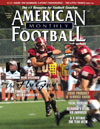AMERICAN FOOTBALL MONTHLY THE #1 RESOURCE FOR FOOTBALL COACHES
Article CategoriesAFM Magazine
|
Football Coaches are Football Savvy, but Just How Movement & Speed Savvy?by: Dale BaskettFootball Speed Specialist © More from this issue For nearly 30 years IĎve worked toward becoming an expert at movement and speed for sports performance. The time spent has been a labor of personal gratification. Iíve worked with the old pros and todayís modern superstars of the NFL. My forte has been developing players at the novice to elite levels. Over the last 29 years, Iíve consulted with 11 NFL teams on speed development and was once on the staff of the Seattle Seahawks. Three years ago, I was approached by Pete Carroll from USC after he watched one of my high school teams train for field-movement speed. He said he had never seen anything like what the athletes were doing movement and speed wise. He wanted me to contact him the following day to talk about working with the Trojans. As the first nationally-recognized speed coach in America, Iíve seen the field grow and cha....The full article can only be seen by subscribers. Subscribe today!
|
|
|||||||
| HOME |
MAGAZINE |
SUBSCRIBE | ONLINE COLUMNISTS | COACHING VIDEOS |
Copyright 2025, AmericanFootballMonthly.com
All Rights Reserved





